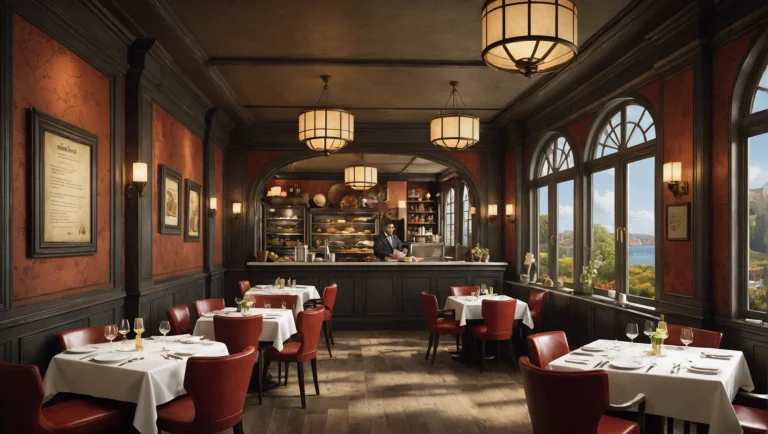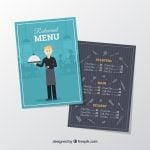Whether you’re a seasoned restaurateur or just starting, you’ll learn how to create a menu that not only showcases your culinary creations but helps your business thrive. Metrobi supports your goals by offering specialized services in delivery for catering companies, ensuring your dishes reach your customers in perfect condition.
Focus on Growing Your Business Let Metrobi handle deliveries so you can spend more time cooking and expanding your restaurant
Get Started TodayBoost customer satisfaction with just a few clicks
Most-Loved Features:
- On-demand drivers
- Real-time GPS tracking
- Delivery confirmation photos
- Over 50% of customers report a smoother delivery experience
What is a Restaurant Menu?
A restaurant menu is a critical tool for communicating offerings and prices to customers
Key components include categorized food and beverage items, descriptions, prices, and dietary information
Menus come in various types, such as à la carte, table d’hôte, cycle, and beverage menus
Essential Elements of a Restaurant Menu
A restaurant menu should include a clear list of all available food and beverage items and their corresponding prices. This information should be organized into logical categories, such as appetizers, entrees, desserts, and drinks, making it easy for customers to navigate and find what they want.
Importance of Ingredients ( Nashville Hot Sauce, Caramelized Onions, Sautéed Green Beans, Roasted Salsa, etc. )
Each menu item should have a brief but enticing description, highlighting the key ingredients and cooking methods used, such as black beans, black pepper, sour cream, green onions, blue cheese, etc. This helps customers make informed decisions and can also showcase the restaurant’s unique selling points, such as locally sourced ingredients or signature dishes.
Additionally, it’s essential to include any relevant dietary information, such as vegetarian, vegan, or gluten-free options for people with a food allergy. This accommodates customers with specific dietary needs and demonstrates the restaurant’s commitment to inclusivity and customer satisfaction.
Healthy Options in the Restaurant Menu
62% of respondents said that healthy food choices are more readily available at lunchtime compared with last year
Types of Restaurant Menus
Restaurants can choose from various menu types based on their concept, target audience, and operational preferences. The most common types include:
À la carte menu
An à la carte menu offers individual dishes that are priced separately, allowing customers to create their own meal combinations. This type of menu provides the most flexibility and is suitable for restaurants with a wide variety of offerings.
Table d’hôte menu
Also known as a set menu or prix fixe, a table d’hôte menu offers a fixed selection of courses at a set price. This type of menu is often used for special occasions or to showcase a chef’s signature dishes.
Cycle menu
A cycle menu is a rotating menu that changes regularly, such as daily, weekly, or monthly. This type of menu is ideal for restaurants that focus on seasonal ingredients or want to keep their offerings fresh and exciting.
Beverage menu
A separate beverage menu is common in many restaurants, particularly those with an extensive red or white wine list or specialty cocktails. This menu may include alcoholic and non-alcoholic drinks, descriptions, and prices.
By understanding the key components and types of restaurant menus, new business owners can create a menu that effectively communicates their offerings, attracts customers, and sets the stage for a successful dining experience. Metrobi aids these food establishments by streamlining their delivery processes, ensuring that their logistical needs for food distribution are efficiently managed.
Metrobi is transforming catering deliveries
Specialized solutions for catering businesses:
- Catering-trained drivers
- Proper handling equipment
- Peak day delivery support
- 23% average cost reduction
Benefits of a Well-Designed Restaurant Menu
Enhances customer experience and satisfaction
Increases profitability and revenue
Improves restaurant operations and efficiency
A well-designed restaurant menu plays a crucial role in the success of your business. It not only informs customers about available options but also serves as a powerful marketing tool that can significantly impact your bottom line. Unlock the secret to boosting your establishment’s appeal and revenue by mastering how to craft a restaurant menu that entices and engages.
If you’re considering adding a sophisticated touch to your dining options, implementing a well-structured prix fixe menu can be an excellent strategy. This menu format, which offers a set selection of courses at a fixed price, not only streamlines the dining experience but can also enhance your restaurant’s reputation. To learn more about creating an enticing prix fixe menu and maximizing its benefits, check out our guide on developing a prix fixe menu.
Enhances Customer Experience
A thoughtfully crafted menu enhances the overall dining experience for your customers. By clearly communicating available options and providing enticing descriptions, you empower patrons to make informed decisions tailored to their preferences. Discover top restaurant menu design templates and access complimentary tools to effortlessly create a captivating menu for your establishment.
For restaurateurs aiming to design or revamp their menus, exploring curated restaurant menu templates can make a significant difference. These templates offer professionally designed layouts that combine aesthetics with functionality, helping you focus on perfecting your menu’s content and branding. Check out these best restaurant menu templates that include free resources to streamline your menu creation process.
Additionally, leveraging expertly crafted and customizable restaurant menu templates can greatly simplify the design process, ensuring your menu is both attractive and user-friendly. These templates often come with free resources and tips that help you highlight key dishes and effectively communicate your brand’s story.
For restaurateurs seeking inspiration and efficiency in menu creation, exploring top-rated restaurant menu design templates can be a game changer. These templates not only offer beautifully designed layouts but also include practical resources that help streamline the entire process, from menu engineering to visual appeal. Discover how to elevate your menu with these accessible and professionally crafted restaurant menu templates that cater to various styles and concepts.
For restaurateurs looking to design or refresh their menus, exploring well-curated restaurant menu templates can be a game-changer. These templates provide a foundation that’s both attractive and functional, allowing you to focus on refining your menu content and branding. Check out these top restaurant menu design templates to jumpstart your menu creation process with style and ease.
Communicates Available Options
A well-organized menu layout with clear categories and easy-to-read descriptions ensures that customers can quickly find dishes that appeal to them. This clarity reduces frustration and enhances satisfaction, as patrons feel confident in their choices.
Helps Customers Make Informed Decisions
Detailed menu descriptions that highlight key ingredients, cooking methods, and unique flavors enable customers to make selections aligned with their dietary needs and taste preferences. This level of transparency builds trust and fosters a positive relationship between your establishment and its patrons.
Streamlines the Ordering Process
A well-structured menu with logical item placement and intuitive navigation streamlines the ordering process. Customers can efficiently peruse options, make decisions, and place their orders without confusion or hesitation. This efficiency improves table turnover rates and enhances overall customer satisfaction.
Increases Profitability
A strategically designed menu can significantly impact your restaurant’s profitability. You can optimize revenue and boost your bottom line by showcasing high-profit items, encouraging upselling and cross-selling, and managing food costs.
Strategically Highlights High-Profit Items
By strategically placing and visually emphasizing high-profit menu items, you can subtly guide customers toward selections that contribute most to your restaurant’s financial success. Techniques such as eye-catching graphics, bold fonts, or prominent placement can draw attention to these profitable dishes.
Encourages Upselling and Cross-Selling
A well-designed menu can encourage customers to explore additional offerings, leading to increased revenue. By suggesting complementary items, such as appetizers, side dishes, or beverage pairings, you create opportunities for upselling and cross-selling. Strategically placed “add-on” options or combo deals can further entice patrons to enhance their orders.
Not Sure if Your Menu Is Doing Its Job?
Request a free 15-minute menu performance review from our experts.
Digital Menu Board
Using digital menu boards may result in an annual gain of $16,000 in in-store sales per unit
Manages Food Costs through Proper Pricing
Effective menu pricing is crucial for managing food costs and ensuring profitability. A well-designed menu takes into account the cost of ingredients, preparation time, and desired profit margins when determining prices. By striking the right balance between perceived value and cost, you can optimize revenue while maintaining customer satisfaction.
Improves Restaurant Operations and Efficiency
A well-crafted menu can streamline restaurant operations and improve overall efficiency. By carefully considering factors such as kitchen capabilities, ingredient availability, and staff expertise, you can create a menu that optimizes workflow and minimizes waste.
Aligns with Kitchen Capabilities and Ingredient Availability
Designing a menu that aligns with your kitchen’s capabilities and available ingredients (such as mixed greens, kinds of garlic, onions, and sesame seeds) is essential for smooth operations. By focusing on dishes that can be executed consistently and efficiently, you reduce the likelihood of bottlenecks and ensure timely service. Additionally, considering seasonal ingredient availability and leveraging local produce can help control costs and showcase your commitment to freshness.
Optimizes Staff Training and Expertise
A well-designed menu takes into account the expertise and training of your staff. By featuring dishes that your team can prepare confidently and consistently, you minimize errors and enhance the overall dining experience. Clear menu descriptions also serve as a training tool, helping staff familiarize themselves with the offerings and confidently answer customer inquiries. Regular menu updates and staff training sessions are crucial to ensure the team stays informed about new items, ingredients, or preparation methods.
Reflects Your Restaurant’s Brand and Concept
Your menu serves as a tangible representation of your restaurant’s brand and concept. It provides an opportunity to showcase your unique identity, culinary style, and overall atmosphere. A well-designed menu can effectively communicate your restaurant’s personality and leave a lasting impression on customers.
Communicates Your Unique Identity
The design elements of your menu, such as color scheme, font choices, and imagery, should align with your restaurant’s overall aesthetic and brand identity. Consistency between your menu design and restaurant decor creates a cohesive experience that reinforces your unique personality and sets you apart from competitors.
Showcases Your Culinary Style
Your menu should reflect your restaurant’s culinary style and showcase the creativity and expertise of your kitchen team. By highlighting signature dishes, incorporating local flavors, or emphasizing specific cooking techniques, you give customers a glimpse into the unique culinary experience they can expect at your establishment. For example, a minimalist layout for a modern bistro or a rustic, handwritten menu for a farm-to-table restaurant can effectively reflect different concepts.
Essential Elements of a Restaurant Menu
Branding and Design
A restaurant’s menu is an extension of its brand identity. The design should be consistent with the overall theme and concept of the establishment. This means incorporating the restaurant’s color scheme, logo, and typography into the menu layout. A visually appealing menu with high-quality images of signature dishes can entice customers and showcase the restaurant’s offerings.
When designing a menu, it’s essential to consider readability. Use a clear, legible font and ensure there’s sufficient contrast between the text and background. Organize the menu items into logical categories, such as appetizers, entrees, and desserts, to make it easy for customers to navigate.
Menu Descriptions
Effective menu descriptions can significantly influence a customer’s ordering decisions. Each dish should have a concise yet enticing description that highlights unique ingredients, cooking methods, or flavor profiles. For example, instead of simply listing “Grilled Salmon,” a more compelling description could be “Wild-caught Alaskan salmon, grilled to perfection and served with a lemon-dill butter sauce.”
When crafting menu descriptions, it’s crucial to mention any allergens or dietary restrictions. This information helps customers with specific dietary needs make informed choices and demonstrates the restaurant’s commitment to accommodating their preferences.
The Art of Menu Engineering
Menu engineering is the strategic design and placement of menu items to maximize profitability. This involves analyzing sales data and food costs to determine which dishes are the most popular and profitable. By prominently featuring high-margin items and using eye-catching designs, restaurants can subtly guide customers toward more profitable choices.
OR Code Menu
Approximately 60% of patrons say they use a restaurant QR code menu or promotional offers
Pricing Strategy
Setting the right prices for menu items is a delicate balance between profitability and customer perception of value. Restaurants should conduct market research to determine competitive pricing based on their target audience and local market conditions. Food costs, labor, and overhead expenses must also be carefully calculated to ensure each dish generates a sufficient profit margin.
Psychological pricing techniques can be employed to make prices appear more attractive to customers. For example, using odd numbers like $9.99 instead of $10 can make a dish seem more affordable, even though the difference is minimal.
Value Perception and Pricing
Customers’ perception of value is not solely based on price but also on factors such as portion size, ingredient quality, and overall dining experience. A higher-priced menu item may still be perceived as a good value if it offers unique flavors, premium ingredients, or an exceptional presentation.
Restaurants can also use bundling strategies, such as prix-fixe menus or combo meals, to provide value to customers while maintaining profit margins. These options give customers the perception of getting more for their money, encouraging them to spend more than they might on individual items.
Menu Variety and Flexibility
A well-designed menu should offer a variety of options to cater to different tastes, dietary restrictions, and preferences. This includes having vegetarian, vegan, and gluten-free options clearly labeled. A diverse menu attracts a wider customer base and encourages repeat visits from diners who want to try different dishes. At Metrobi, we support food businesses by providing delivery services across more than 20 US cities, Newark included, to ensure their diverse menus reach a wide audience efficiently.
Flexibility is another key aspect of a successful menu. Offering customizable options, such as build-your-own pizzas or salads, allows customers to tailor their meals to their liking. This level of personalization enhances the dining experience and can lead to increased customer satisfaction and loyalty. Expanding delivery options can further enhance customer convenience and satisfaction. For restaurants aiming to reach a broader audience in Florida, partnering with a reliable service like Metrobi’s Miami courier service ensures timely and professional delivery, helping businesses maintain quality and promptness.
To amplify your restaurant’s reach in the competitive Miami market, consider enlisting the help of expert Miami delivery couriers. These professionals specialize in quick and secure food delivery, allowing you to focus on your culinary creations while ensuring customers receive their orders fresh and on time. Partnering with reliable Miami couriers can enhance customer satisfaction and boost repeat business.
Restaurant Menu Choices
Over the next 12 months, 88% of restaurants intend to grow outside of their current menu choices
Seasonal Updates and Specials
Regularly updating the menu with seasonal ingredients and specials keeps the offerings in-house both fresh and exciting. This approach allows the restaurant to showcase the chef’s creativity while taking advantage of seasonal produce that is often more flavorful and cost-effective.
Featuring limited-time specials or daily chef’s recommendations can create a sense of urgency and exclusivity, encouraging customers to visit more frequently to try new dishes before they’re gone. These updates also provide opportunities for the restaurant to test new recipes and gauge customer response before adding them to the permanent menu.
In conclusion, a well-designed restaurant menu is a powerful tool for attracting and retaining customers. By focusing on branding, dish descriptions, pricing strategy, variety, and seasonal updates, new restaurant owners can create a menu that effectively showcases their offerings, enhances the dining experience, and ultimately contributes to the success of their business.
Restaurant Menu Design Tips
Keep it Simple and Organized
A well-organized menu is crucial for providing a positive dining experience. Limit the number of items on your menu to avoid overwhelming customers with too many choices.
Group Items by Category
Grouping menu items by category, such as appetizers, entrees, and desserts, makes it easier for customers to navigate the menu and find what they want. Use clear and descriptive category headings to help customers quickly identify their options.
Use Clear and Legible Fonts
Choose fonts that are easy to read, even in dimly lit environments. Sans-serif fonts like Arial or Helvetica are often preferred for their clarity. Ensure that the font size is large enough for customers to read comfortably, typically 12 points or larger.
Highlight Signature Dishes
Showcasing your restaurant’s unique or popular items can help guide customer choices and increase sales. Use visual cues, such as boxes or icons, to draw attention to these dishes. Place them in prominent positions on the menu, such as the top or center of the page.
Use High-Quality Images
Include high-quality images of your signature dishes to entice customers and give them a clear idea of what to expect. Images can be particularly effective for showcasing visually appealing items like desserts or specialty cocktails.
Consider Menu Size and Material
The size and material of your menu can impact the overall dining experience. Choose a size that is easy for customers to handle and fits comfortably on your tables. Consider the restaurant’s ambiance when selecting menu materials, such as leather for an upscale steakhouse or recycled paper for small plates at an eco-friendly cafe.
Digital Menu Options
In the digital age, consider offering digital menu options to provide flexibility and cost-effectiveness. Digital menus can be easily updated and allow for dynamic pricing and promotions. Additionally, try incorporating active images using an animation maker to bring your digital menus to life and enhance customer engagement. They also provide a contactless ordering option, which has become increasingly important in the wake of the COVID-19 pandemic. Metrobi assists food establishments by handling their delivery operations, offering an efficient service for delivering meals.
Incorporate Your Brand Identity
Your menu design should reflect your restaurant’s brand identity and create a cohesive dining experience. Use colors, fonts, and imagery that align with your brand and evoke the desired atmosphere. Consistency in design across all marketing materials, including your website and social media, can help reinforce your brand and create a lasting impression on customers.
Optimize Menu Layout for Profitability
Strategically placing high-profit margin items in prominent positions on the menu can help increase sales and boost profitability.
Use Decoy Pricing
Consider using decoy pricing to guide customer choices towards higher-profit items. By placing a slightly more expensive item next to a lower-priced option, customers may perceive the lower-priced item as a better value, increasing its likelihood of being chosen.
Restaurant Menu Pricing Strategies
Restaurant Menu Prices
73% of restaurants plan to continue increasing prices in 2023
Cost-Plus Pricing
Cost-plus pricing is a straightforward approach where the menu price is determined by calculating the cost of each dish and adding a markup for profit. This method ensures that the restaurant covers its expenses and generates a desired profit margin.
To implement cost-plus pricing, restaurant owners must have a clear understanding of their food costs, including ingredients, labor, and overhead expenses. By accurately calculating these costs, they can set prices that guarantee profitability.
However, cost-plus pricing has its limitations. It may not take into account market demand or the perceived value of the dish to the customer. If the calculated price is too high compared to competitors or doesn’t align with the target market’s expectations, it could negatively impact sales.
Determining Food Costs
To calculate food costs, restaurant owners should:
Break down each dish into its ingredients
Determine the cost of each ingredient based on purchase price and portion size
Factor in labor costs, such as the time required for preparation and cooking
Include a portion of overhead expenses, such as rent, utilities, and equipment maintenance
Once the total cost per dish is calculated, a markup percentage can be added to determine the menu price. Common markup percentages in the restaurant industry range from 25% to 50%, depending on the type of establishment and target profit margins.
Competitive Pricing
Competitive pricing involves analyzing the prices of similar dishes offered by competing restaurants in the market. By understanding the local market’s pricing landscape, restaurant owners can position their menu items strategically.
Conducting a thorough competitive analysis is essential for implementing this pricing strategy effectively. Restaurant owners should visit competitors’ establishments, review their menus, and note the prices of comparable dishes. Online menu aggregators and delivery platforms can provide valuable insights into competitors’ pricing.
Based on the analysis, restaurant owners can decide whether to price their dishes higher, lower, or on par with competitors. Pricing higher may be justified if the restaurant offers unique or superior quality dishes, while pricing lower can attract price-sensitive customers and help establish market share.
Positioning and Perceived Value
When determining competitive prices, restaurant owners should also consider their target market’s preferences and the perceived value of their dishes. If the restaurant aims to position itself as a premium or luxury establishment, prices may be set higher than competitors to reinforce that perception.
On the other hand, if the restaurant targets a more budget-conscious audience, pricing dishes lower than competitors can be an effective strategy to attract customers. However, it’s crucial to ensure that the lower prices do not compromise the quality of ingredients or the dining experience.
Psychological Pricing
Psychological pricing strategies leverage customer perceptions and subconscious decision-making processes to influence purchasing behavior. By understanding how customers perceive prices, restaurant owners can optimize their menu pricing to drive sales and enhance profitability.
One common psychological pricing technique is odd-even pricing, known as “charm pricing.” This involves setting prices that end in odd numbers, such as $9.99 or $14.95. Studies have shown that customers perceive prices ending in odd numbers as more attractive and affordable compared to round numbers.
Another technique is anchoring, where a higher-priced item is placed strategically on the menu to make other items appear more reasonable in comparison. For example, featuring a premium dish at a significantly higher price can make other dishes seem like better value options.
Bundling is another psychological pricing strategy that combines multiple items into a single package at a discounted price. By offering meal combos or prix-fixe menus, restaurants can encourage customers to purchase more items while perceiving the bundle as a better value.
Menu Design and Pricing Psychology
The visual design of the menu can also influence customers’ perception of prices. Techniques such as removing the currency symbol, using a smaller font size for prices, or placing prices at the end of dish descriptions can minimize the emphasis on cost and shift focus toward the dish’s appeal.
Balancing Pricing Strategies
Effective menu pricing often involves a combination of cost-plus, competitive, and psychological pricing strategies. Restaurant owners should consider their unique business goals, target market, and brand positioning when determining the most appropriate pricing approach.
Regularly reviewing and adjusting menu prices is crucial to maintain profitability and stay competitive in the market. Factors such as changes in ingredient costs, shifts in customer preferences, and economic conditions may necessitate price adjustments over time.
Restaurant owners should also monitor sales data and customer feedback to evaluate the effectiveness of their pricing strategies. If certain menu items are not selling well or customers express dissatisfaction with prices, it may be necessary to reassess and make adjustments.
Prices of the Restaurant Menu
Menu prices have risen 8.2% in the last 12 years
Testing and Optimization
Implementing new pricing strategies or making significant price changes can be risky. To mitigate potential negative impacts, restaurant owners can conduct small-scale tests or pilot programs before rolling out changes across the entire menu.
For example, introducing a new pricing strategy for a limited time or applying it to a specific section of the menu can provide valuable insights into customer reactions and sales impact. Based on the results, restaurant owners can refine their pricing approach and make data-driven decisions.
Crafting a Menu for Your Target Market
Understand Your Customer Demographics
When crafting your restaurant menu, it’s crucial to consider your target market’s demographics, such as age, income level, and dining preferences. A menu designed for a family-friendly casual dining establishment will differ significantly from one created for an upscale fine dining restaurant.
Adapt to Local Tastes and Trends
Incorporating local ingredients and regional dishes into your menu can help you connect with your community and showcase your restaurant’s unique identity.
Staying updated on current food trends and dietary preferences is also essential. The rise of plant-based diets, for example, has led many restaurants to offer more vegan and vegetarian options.
Offer a Balance of Familiar and Unique Items
A successful restaurant menu strikes a balance between classic dishes that customers expect and signature items that set your establishment apart.
Classic Dishes
Include familiar favorites that align with your restaurant’s concept, such as burgers for a casual American eatery or pasta dishes for an Italian restaurant. These classic offerings provide a sense of comfort and reliability for customers.
Signature Items
Develop unique signature dishes that showcase your restaurant’s creativity and culinary expertise. These items should reflect your brand identity and help differentiate your establishment from competitors. Signature dishes can also generate buzz and attract food enthusiasts eager to try something new.
By understanding your target market, adapting to local tastes and trends, and offering a balance of familiar and unique items, you can create a menu that resonates with your customers and sets your restaurant up for success.
Creating Your Restaurant’s Perfect Menu
By understanding the key components of a well-designed menu, you can create a powerful tool that enhances your customers’ dining experience and boosts your restaurant’s profitability. Focus on crafting a visually appealing, well-organized menu that showcases your signature dishes and appeals to your target market.
As you develop your restaurant menu, remember to:
Keep it simple, organized, and visually appealing
Highlight your unique offerings and crowd-pleasers
Price strategically to ensure profitability and customer satisfaction
Tailor your menu to your target market’s preferences and local trends
With these essentials in mind, you’re well on your way to creating a menu that will delight your customers and help your restaurant thrive. So, what’s the first step you’ll take in crafting your perfect menu? For restaurant owners looking to expand their delivery capabilities, partnering with a reliable service can make all the difference. Metrobi offers an impressive Dallas same-day delivery service, ensuring your culinary creations reach customers quickly and in perfect condition, helping you maintain excellent customer satisfaction and grow your business.
Expanding your delivery reach is key to capturing new audiences and increasing sales. To truly optimize your distribution, consider integrating Metrobi’s fast and dependable Dallas delivery solutions into your operations. This service ensures your food arrives fresh, on time, and delights customers with every order.














